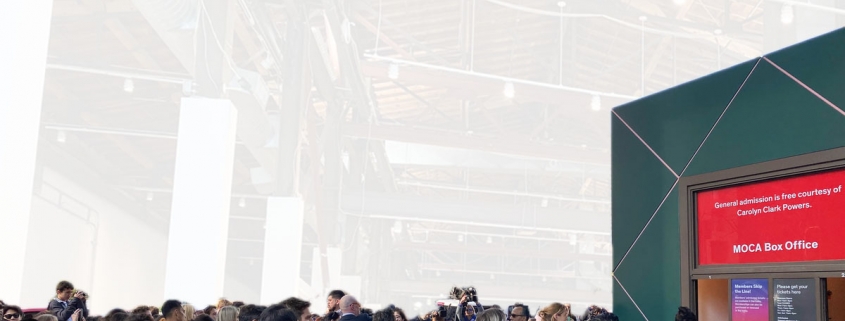New Year, New MOCA: Free general admission draws crowds

Entry fees became a thing of the past last weekend when the Museum of Contemporary Art celebrated its new policy of free admission with the aptly named “Art for All” festival at its Grand Avenue and Little Tokyo locations.
Free admission as well as free tours of the galleries will continue at MOCA for the foreseeable future.
“Today is the first official launch day of MOCA offering free general admission,” MOCA Chief Communications Officer Sarah Stifler said. “It is a day where we are celebrating the museum, the arts community, creativity and our friends and neighbors in Los Angeles.”
Free admission at MOCA was made possible by a $10 million gift from the MOCA Board of Trustees President Carolyn Powers. Powers’ goal was to remove the financial barriers to entry by doing away with the museum’s previous $15 entry fee.
“I think when you work in a museum and in an arts organization and you have been doing this for a long time, you realize … that art museums should be more akin to libraries,” Stifler said about Powers’ contribution. “They should be a place that you should come [into] and be inspired, learn something, be challenged and see new things and have new experiences, and you shouldn’t necessarily have to pay for that.”
“Art for All” featured myriad exhibitions, artists and art-making activities. At MOCA Grand Avenue, “Dream City,” a video piece by Los Angeles-based artist Ulysses Jenkins, played on a loop in the Ahmanson Auditorium as visitors toured the exhibitions above and enjoyed live jazz music outside in MOCA’s Arco Court.
Jenkins’ work was a disconcerting video collage of music, dance, color and sound that was created in response to Ronald Reagan’s presidency and questioned the current state of American society. According to Stifler, the museum was deliberate in its decision to feature Jenkins’ work at the festival.
“We were very specific in who we reached out to,” Stifler said. “We were very specific in wanting to reach out to our neighbors and our immediate community.”
In a similar vein, TAIKOPROJECT, a Los Angeles group of young, emerging Taiko drummers, was invited to perform at the Geffen Contemporary at MOCA in Little Tokyo during the festival. Taiko is a centuries-old form of Japanese drumming that involves a range of percussion instruments, some of which weigh up to 100 pounds.
The deep sound of the TAIKOPROJECT’s drums echoed throughout the festival during the group’s performance. According to TAIKOPROJECT’s Artistic Director Masato Baba, Taiko provided a way for their ancestors to reconnect with their Japanese culture after it was stripped away from them during internment in the 1940s.
Now, as second-generation Taiko drummers, Baba and his group hope to expand and experiment with the possibilities of the art form.
“We want to push the boundaries of what Taiko can be in terms of adding rock, hip-hop, jazz influences and even various types of dance,” Baba said. “Taiko is a very wide-open art form and is open for interpretation currently — people in Japan might tell you different — but here we’re just trying to do what speaks to us [and] at the same time remember where it came from as well.”
In addition to TAIKOPROJECT, the Geffen also hosted several art-making activities. At Art’s Barrio Mobile Art Studio, artists Barrio Mobile Art Studio, artists from Self Help Graphics & Art, an East L.A. community arts center, assisted families and other attendees in stencil silkscreen workshops. Other workshops at the Geffen allowed children to create their own mini sculptures.
Traditional exhibitions were on display as usual at MOCA Grand Avenue, where visitors observed and listened to tour guides discuss a swath of diverse works ranging from the Color Field paintings of Mark Rothko to the more unfamiliar works of Valerie Jaudon.
Despite the fanfare and generally positive attention the event received, not everyone in attendance was convinced that MOCA’s vision of a diversified audience would pan out.
Barry Canty, an Angeleno and frequent MOCA visitor, was not sure that admission prices were the reason people from lower income backgrounds were not attending.
“I think consumption of art in general is not necessarily connected to one’s ability to afford it,” Canty said. “I think there are certain behaviors that are associated with particular lifestyles, and I think if people come from lower income backgrounds, very often they don’t see art consumption as something they have time to do — it’s more of a luxury.”
Cindy Rozas, who attended MOCA once or twice before, said she was hopeful about MOCA’s efforts to include diverse museumgoers but recognized that there is room for improvement.
“I think [the museum’s admissions efforts] will help because it will make it accessible to everyone and people won’t have the barrier of entry [of] having to pay,” Rozas said. “But I think there is still a lot of work to be done to make sure that the communities that don’t come here have access to come and that they are welcomed and that they feel that this is art for them as well.”

